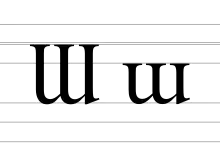| Turned M | |
|---|---|
| Ɯ ɯ | |
 | |
.svg.png.webp) | |
| Usage | |
| Type | alphabetic |
| Language of origin | International Phonetic Alphabet, Yakut language, Tsakhur, Standard Zhuang, Dan language, Chami language |
| Phonetic usage | /ɨˤ/, /ɯ/ |
| Unicode codepoint | U+0193, U+026F |
| History | |
| Development |
|
| Other | |
Ɯ (minuscule: ɯ) (also ![]()
![]() ) is a letter that was used in the Zhuang alphabet from 1957 to 1986 to represent a close back unrounded vowel /ɯ/. At some time in or before 1986, it was replaced with W. It was also used in Semyon Novgorodov's Yakut alphabet.
) is a letter that was used in the Zhuang alphabet from 1957 to 1986 to represent a close back unrounded vowel /ɯ/. At some time in or before 1986, it was replaced with W. It was also used in Semyon Novgorodov's Yakut alphabet.
In the International Phonetic Alphabet, it is used to represent the same vowel.
In some fonts, it is homoglyphic with the Cyrilllic letter Sha, and in this manner it was used in the Tsakhur language,[1] representing the pharyngealized close central unrounded vowel /ɨˤ/. It is represented today by the digraph ЫI.
Usage on computers
| Preview | Ɯ | ɯ | ||
|---|---|---|---|---|
| Unicode name | LATIN CAPITAL LETTER TURNED M | LATIN SMALL LETTER TURNED M | ||
| Encodings | decimal | hex | dec | hex |
| Unicode | 412 | U+019C | 623 | U+026F |
| UTF-8 | 198 156 | C6 9C | 201 175 | C9 AF |
| Numeric character reference | Ɯ | Ɯ | ɯ | ɯ |
References
- ↑ "www.unicode.org/L2/L2011/11360-soviet-latin.pdf" (PDF). October 18, 2011. Retrieved April 28, 2023.
This article is issued from Wikipedia. The text is licensed under Creative Commons - Attribution - Sharealike. Additional terms may apply for the media files.